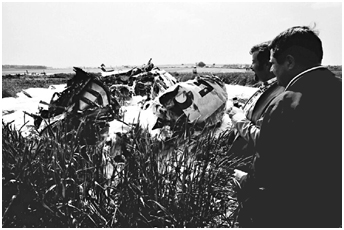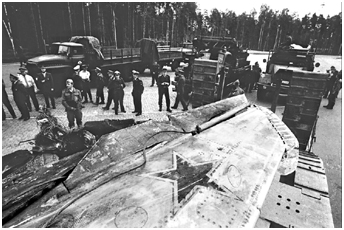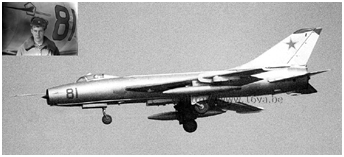The Sukhoy fallen from the sky

 Almost six years after Yepatko defected aboard his MiG-17, it was the turn of comrade Yevgeni Lvoich (1) to check if the grass was really greener among the Western imperialists!
Almost six years after Yepatko defected aboard his MiG-17, it was the turn of comrade Yevgeni Lvoich (1) to check if the grass was really greener among the Western imperialists!
On Sunday May 27, 1973, a Su-7BM of 497.IBAP from Grossenhain crashed in a field after its pilot ejected near Braunschweig in the British zone. In reality, Lieutenant Y. Lvoich, born June 29, 1952, would have been a technical
officer, with no piloting experience. But the story is not clear: was he a pilot with a particular function (as there was for example a chief navigator within each unit) or ground staff as some accounts suggest?
In addition, the account of his escape is questionable because the press articles of the time which, admittedly, are not gospel (2), do not agree on certain points.
Be that as it may, E. Lvoich managed to steal the Su-7BM n°52 (s/n 5411) from the regiment on this Sunday in the spring of 1973. He would have bypassed a vehicle that was blocking his way, dropped the tanks after take-off
and would have flown in the direction of the FRG with the landing gear down! Note however that on the many photos illustrating this article (link at the bottom of the page), no landing gear can be seen
except the nose wheel. Wasn't it retracted then? Also, one can distinguish the empennages of a drop tank on a photograph.
On the other hand, the photos show that the guns were loaded and also that one or two loaded rocket pods were mounted.

 It turns out that the easiest route to reach the inner German border from Grossenhain was to fly in a straight line after taking off from the SE end of the runway oriented SE-NO on heading 300.
The flight of a duration of about 15 minutes took place at low altitude in order to avoid a possible interception, several fighter airfields being near its route.
No less than thirty interceptors would have been launched after the fugitive, probably too late to have a chance of finding the transfuge. At 11.45 a.m., Lvoich crossed the border undetected by NATO radars and gained altitude
in order to eject. He jumped at 11:47 a.m. and landed in a field south of Klein Schöppenstedt near a Bundeswehr military training ground designated "Herzogberge" (3),
east of Braunschweig. Police and firefighters quickly arrived on the scene while the Su-7 wreckage burned down with what little fuel was left on board.
The wreck of the plane was then evacuated and sheltered in the "Hindenburg" barracks in Braunschweig where experts, technicians and Allied intelligence services could examine and dissect it at leisure.
It turns out that the easiest route to reach the inner German border from Grossenhain was to fly in a straight line after taking off from the SE end of the runway oriented SE-NO on heading 300.
The flight of a duration of about 15 minutes took place at low altitude in order to avoid a possible interception, several fighter airfields being near its route.
No less than thirty interceptors would have been launched after the fugitive, probably too late to have a chance of finding the transfuge. At 11.45 a.m., Lvoich crossed the border undetected by NATO radars and gained altitude
in order to eject. He jumped at 11:47 a.m. and landed in a field south of Klein Schöppenstedt near a Bundeswehr military training ground designated "Herzogberge" (3),
east of Braunschweig. Police and firefighters quickly arrived on the scene while the Su-7 wreckage burned down with what little fuel was left on board.
The wreck of the plane was then evacuated and sheltered in the "Hindenburg" barracks in Braunschweig where experts, technicians and Allied intelligence services could examine and dissect it at leisure.

 However, the press questions part of this version. Thus, according to the New York Times of May 28, 1973 or the German newspapers, a spokesperson for the German Federal Government affirmed that the pilot had taken
88 minutes to complete a journey that normally requires only around twenty. It should be noted that a Su-7BM equipped with drop tanks and armed with a ton of bombs could hold the air up to 1H37.
Der Spiegel stated that after crossing the border to the west, Lvoich had first taken a NE heading, suggesting that he had gotten lost.
Would he have extended his flight for an hour (still without being spotted) to consume fuel before the ejection? Was flight time only estimated based on fuel tanks capacity?
Whatever the truth, and although an officer of the Bundeswehr reportedly said about him that he was only a "poor redneck", Y. Lvoich turned out to be a godsend for Western intelligence services as
evidenced by a BND report dated July 24, 1973 (> Link) (4).
In addition to the aircraft itself, it was above all the information about the use of tactical nuclear weapons, their storage and the associated procedures that had, one could say, the effect of a bomb...
As one interrogator of the Soviet defector summed it up: "This report was the first solid proof of the storage of atomic weaponry by the Frontal Aviation of the Soviet Union!"
E. Lvoich disappeared from the radar screens after being granted political asylum. As for the remains of his aircraft, while the Soviets demanded their immediate return, they only recovered them on May 31, 1973,
quite logically at the Helmstedt border crossing point east of Braunschweig.
However, the press questions part of this version. Thus, according to the New York Times of May 28, 1973 or the German newspapers, a spokesperson for the German Federal Government affirmed that the pilot had taken
88 minutes to complete a journey that normally requires only around twenty. It should be noted that a Su-7BM equipped with drop tanks and armed with a ton of bombs could hold the air up to 1H37.
Der Spiegel stated that after crossing the border to the west, Lvoich had first taken a NE heading, suggesting that he had gotten lost.
Would he have extended his flight for an hour (still without being spotted) to consume fuel before the ejection? Was flight time only estimated based on fuel tanks capacity?
Whatever the truth, and although an officer of the Bundeswehr reportedly said about him that he was only a "poor redneck", Y. Lvoich turned out to be a godsend for Western intelligence services as
evidenced by a BND report dated July 24, 1973 (> Link) (4).
In addition to the aircraft itself, it was above all the information about the use of tactical nuclear weapons, their storage and the associated procedures that had, one could say, the effect of a bomb...
As one interrogator of the Soviet defector summed it up: "This report was the first solid proof of the storage of atomic weaponry by the Frontal Aviation of the Soviet Union!"
E. Lvoich disappeared from the radar screens after being granted political asylum. As for the remains of his aircraft, while the Soviets demanded their immediate return, they only recovered them on May 31, 1973,
quite logically at the Helmstedt border crossing point east of Braunschweig.
PS You have to believe that the Braunschweig area exerted a certain magnetism on the pilots from Grossenhain. Indeed, on September 17, 1987, a Su-24 of the 497.BAP (formerly 497.IBAP/APIB) flew over the city because of some navigation problems! But that's another story and we'll talk about it when we tackle the bomber units.
With special thanks to Wolfgang Roehl for his photo collection
 |
Su-7 Transfer PHOTO PAGE |  |
notes
(1) According to sources, the name would be Yevgeni Vronsky.
(2) Thus, an article published in the Braunschweiger Zeitung of May 29, 1973 claimed that "Galosh" anti-missile missiles had been found in the
wreckage (Wie weiter bekannt wurde sollen die fachleute vor allem nach raketen-abwehrraketen (Nato code Galosh) in dem wrack gesucht
und sie auch gefunden haben). But the 5V21 missile aka ABM-1 "Galosh" for NATO was an anti-ballistic missile longer than a Su-7 and weighing
more than 32 tons! (> Link). It is true that a little further, it was specified that this information was not, like others, yet confirmed...
(3)
Military training ground from 1934 to 1945 and from 1958 to 2003 - became a nature reserve in 2016.
(4)
It should be noted that this report contains errors, such as point n°5 where it is specified that the nuclear bombs did not require a dedicated
pylon.
 |
Plan du site - Sitemap |  |
